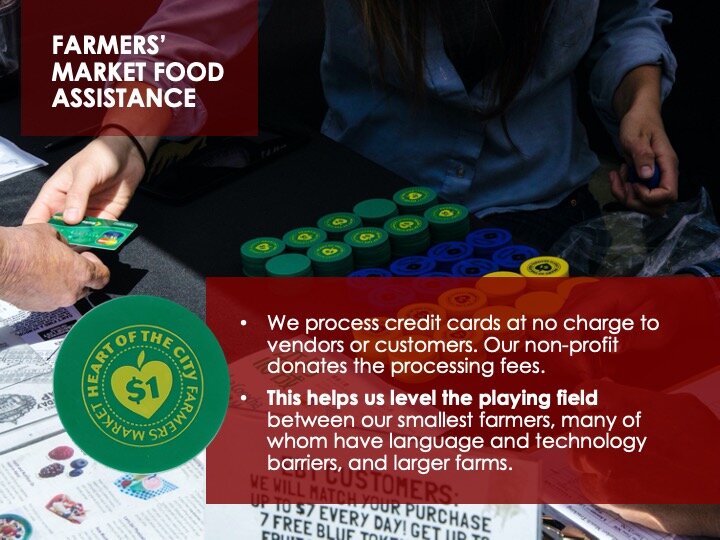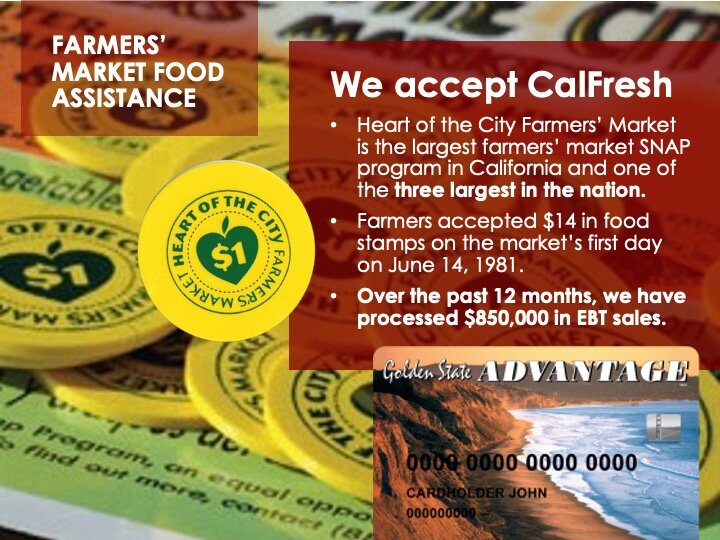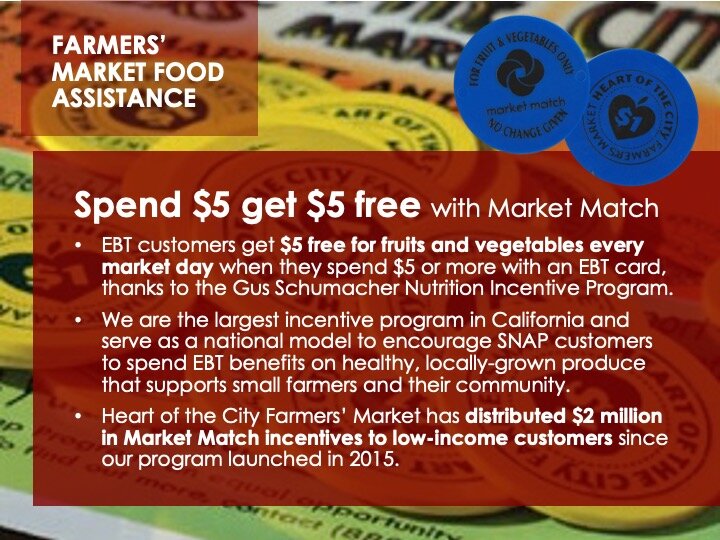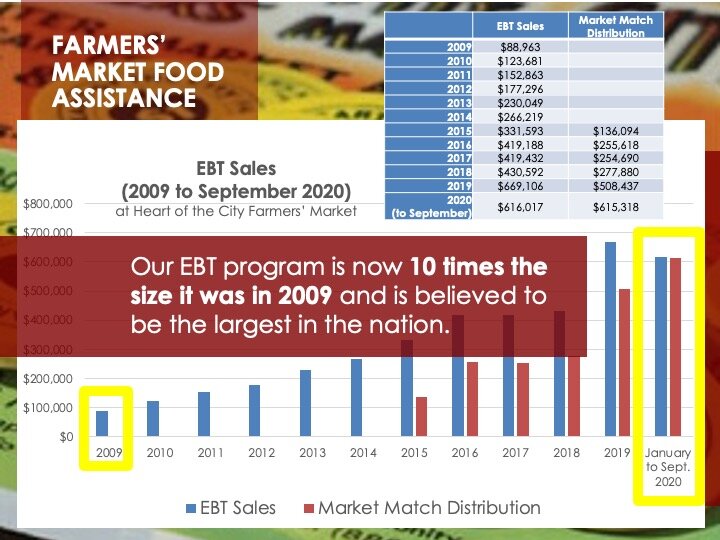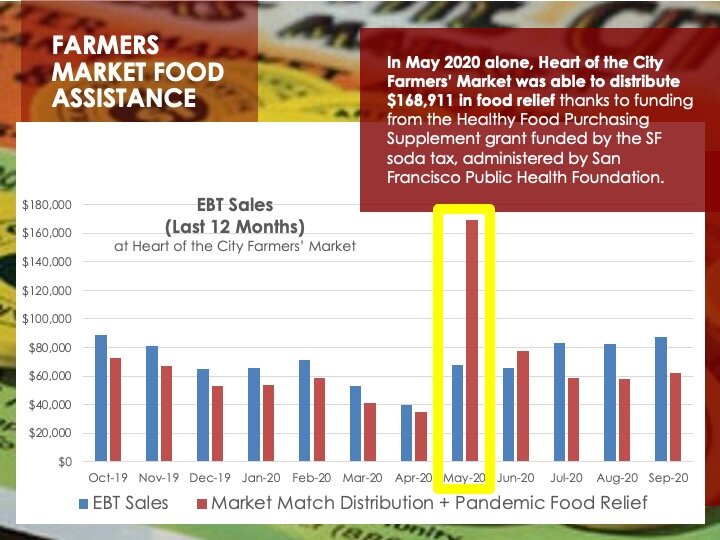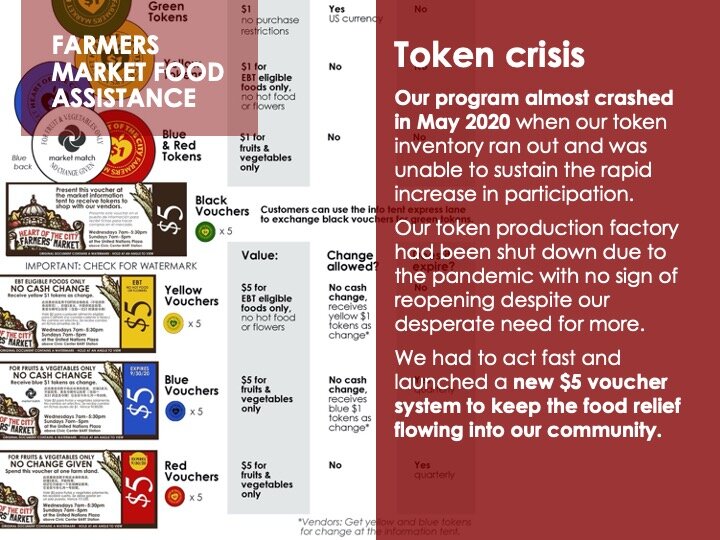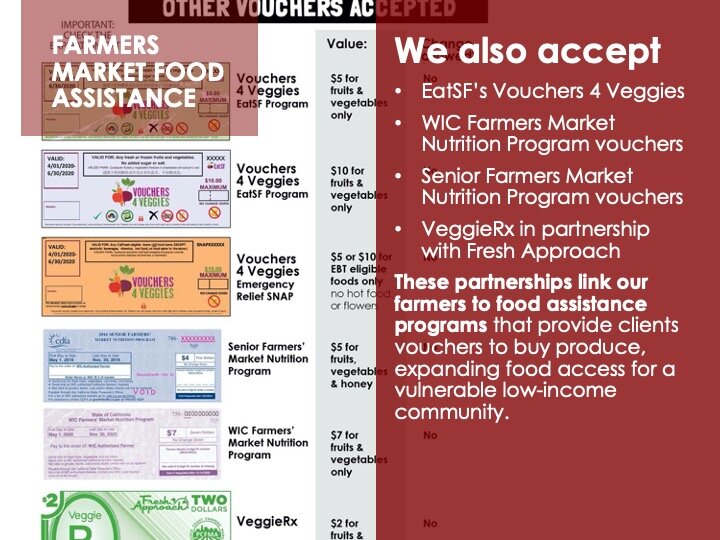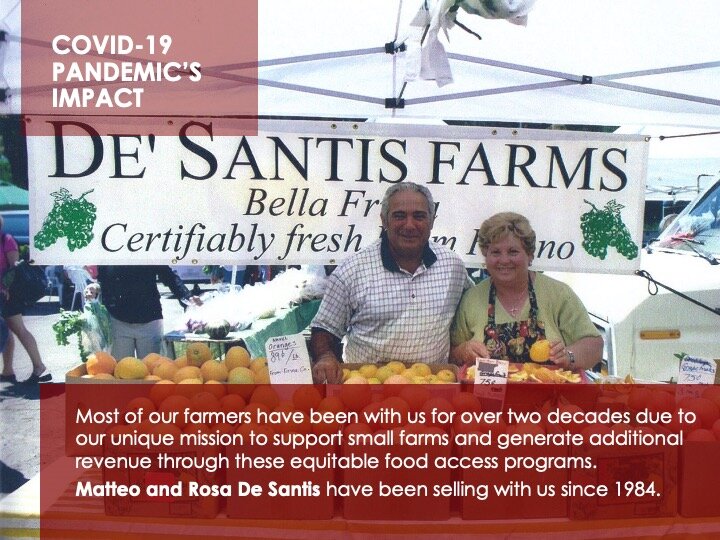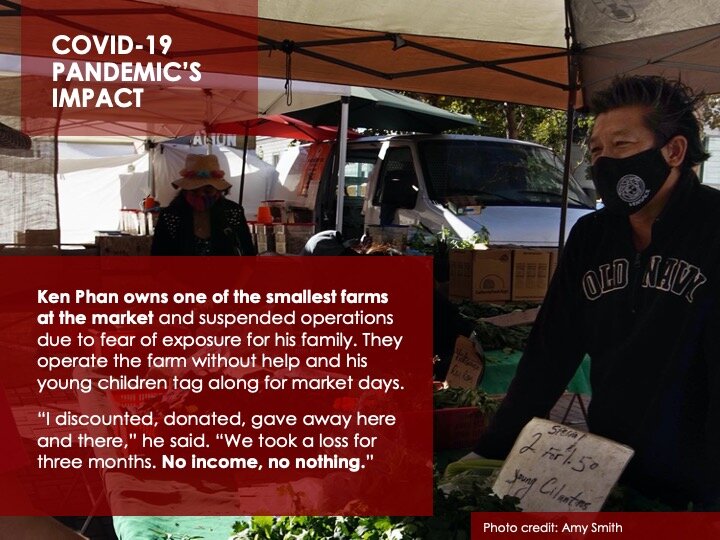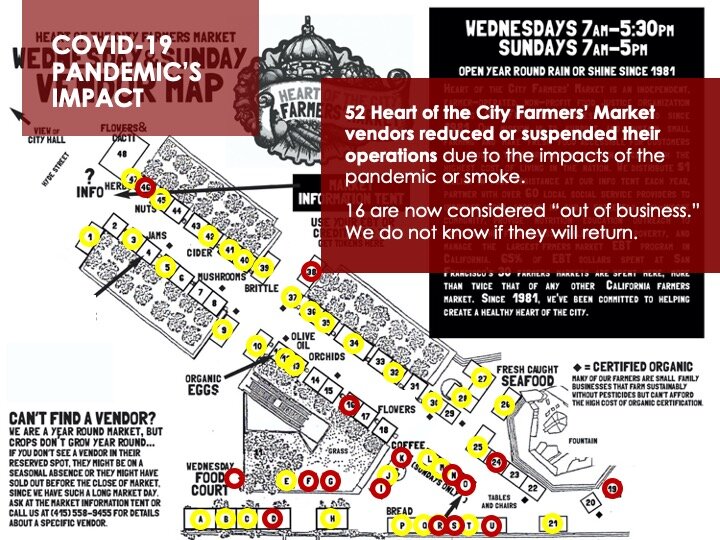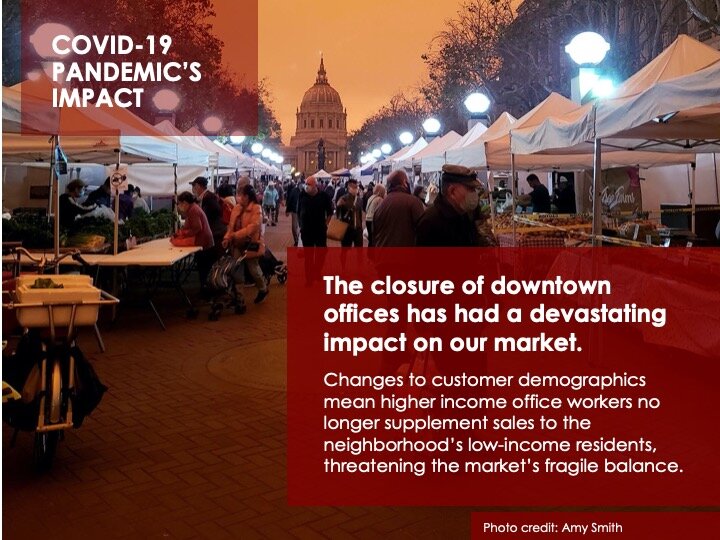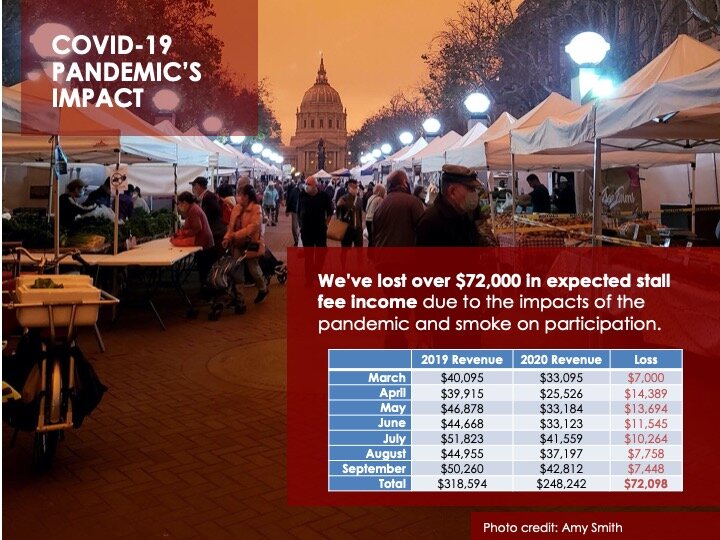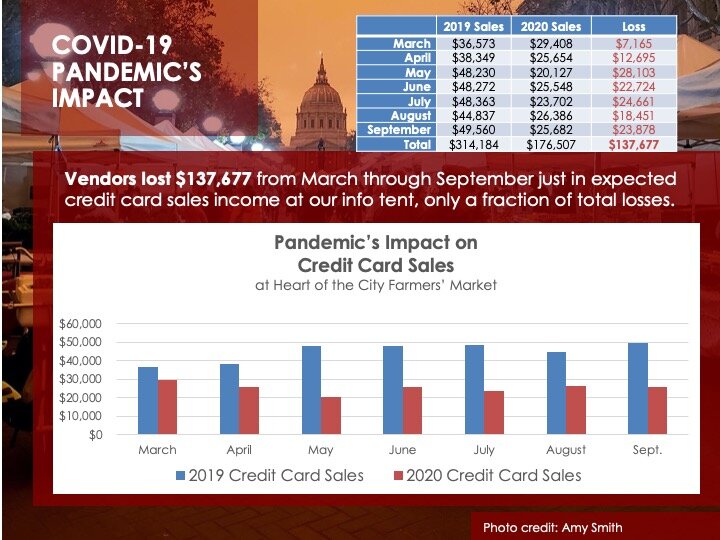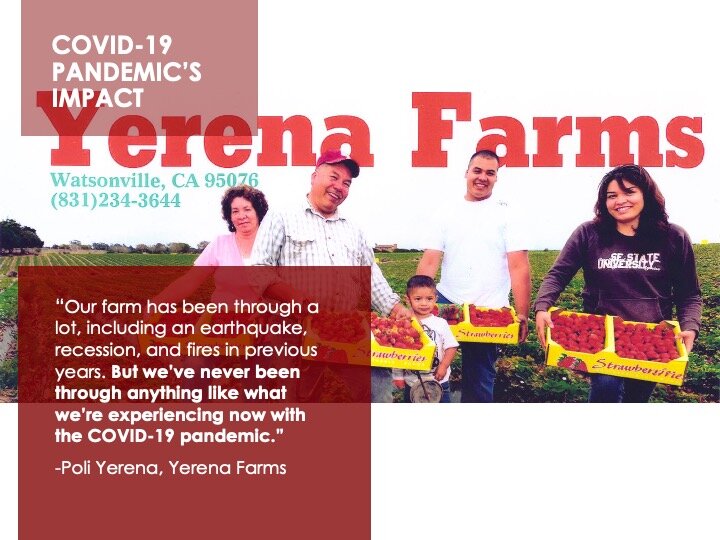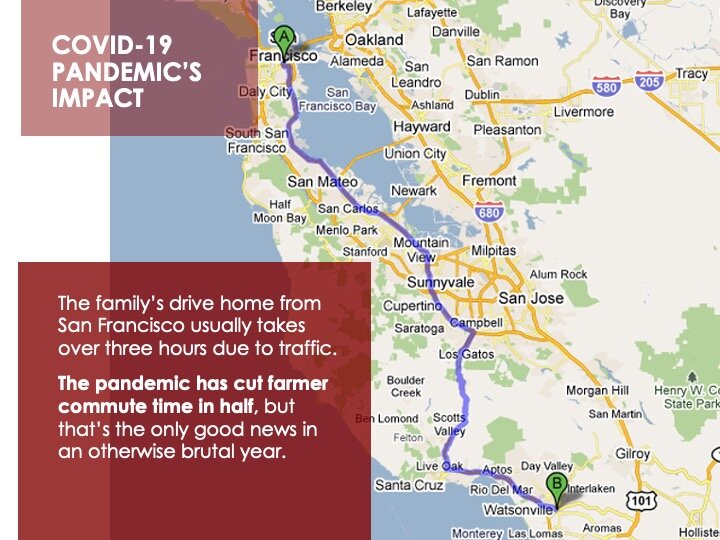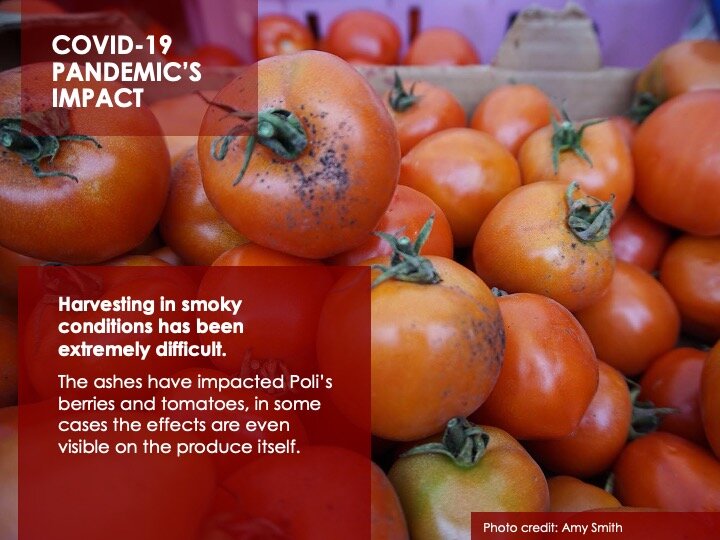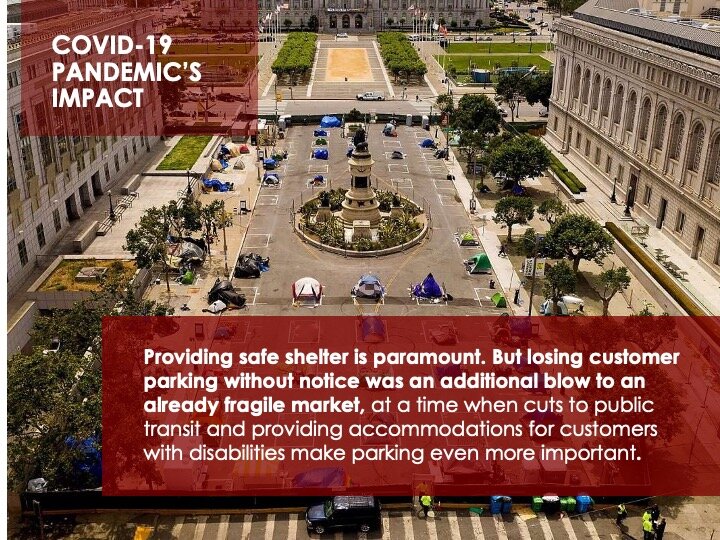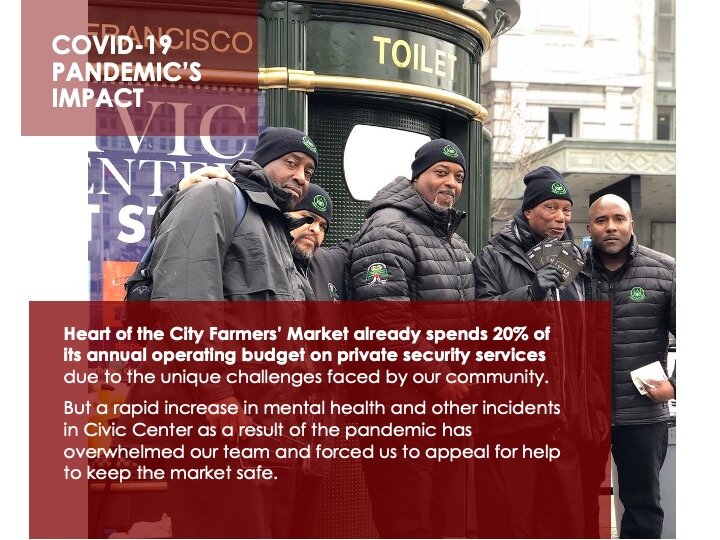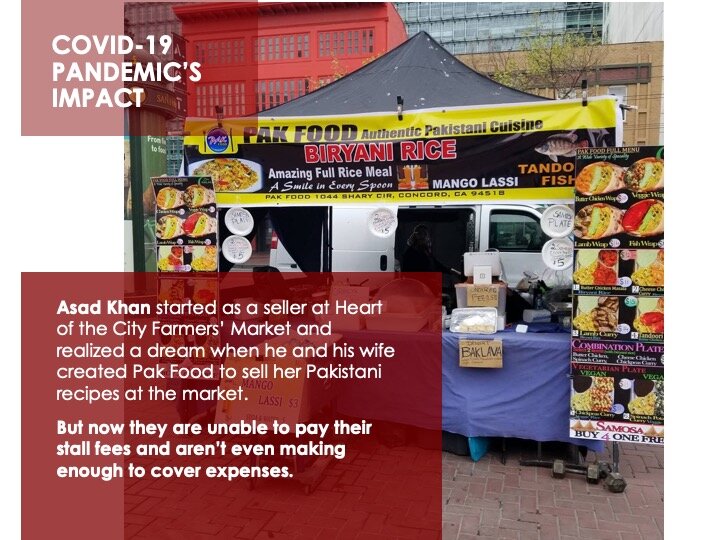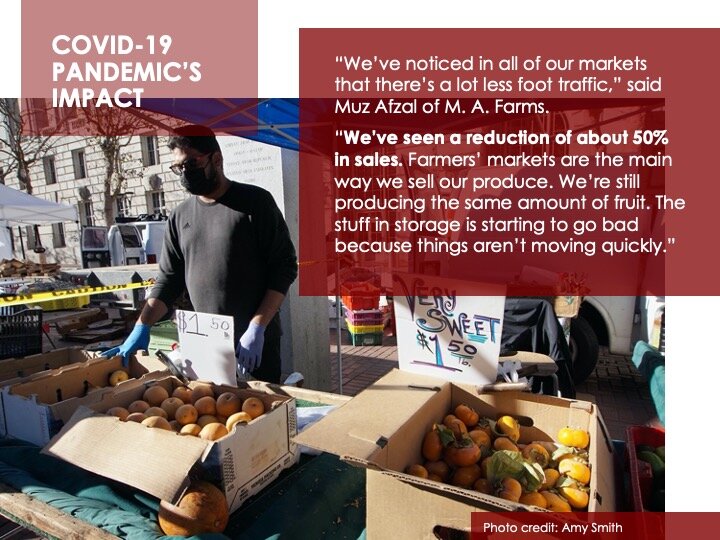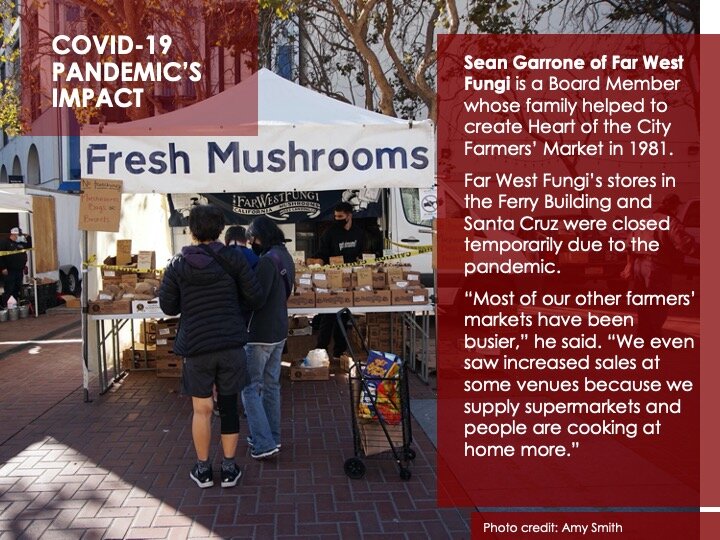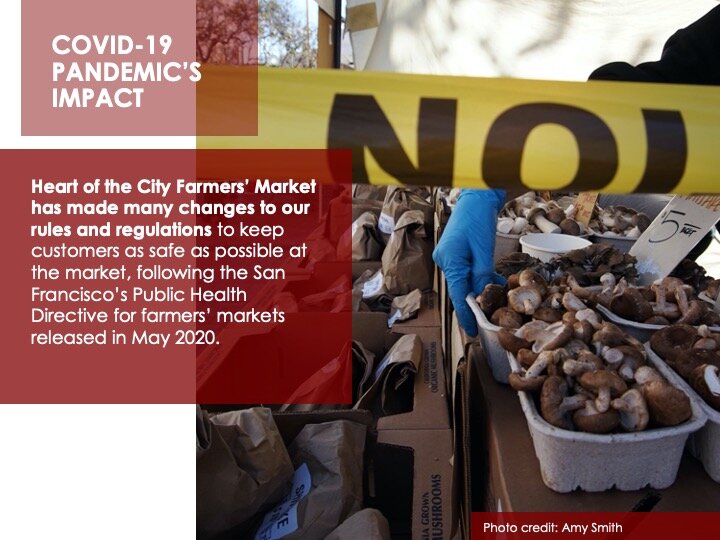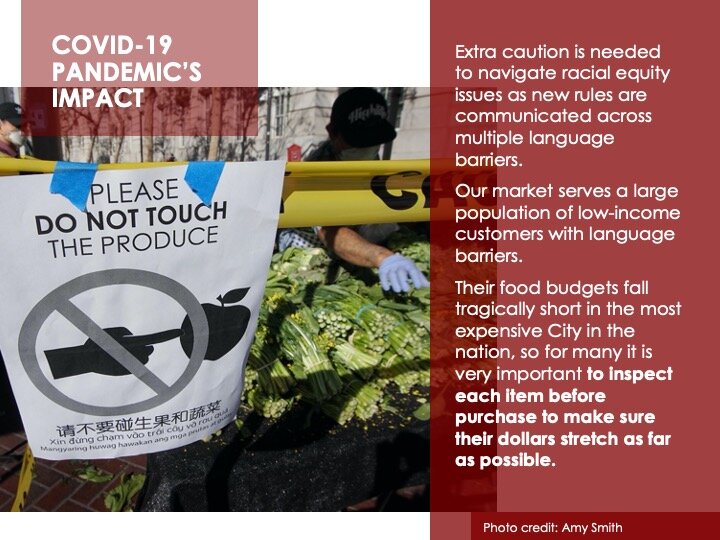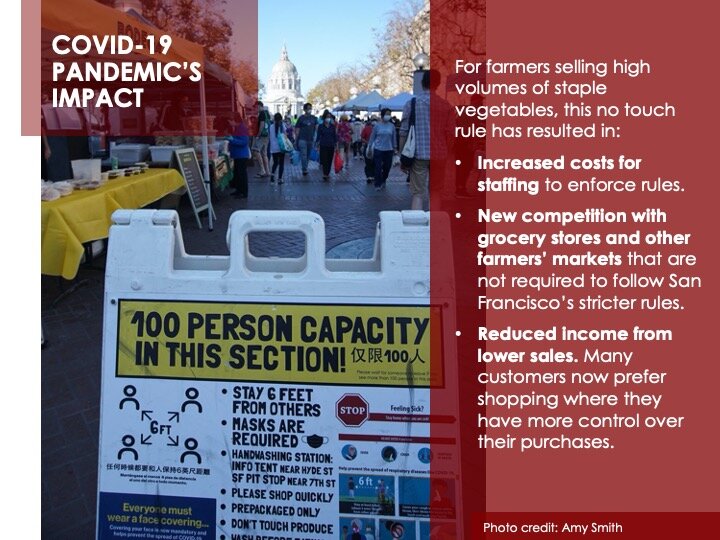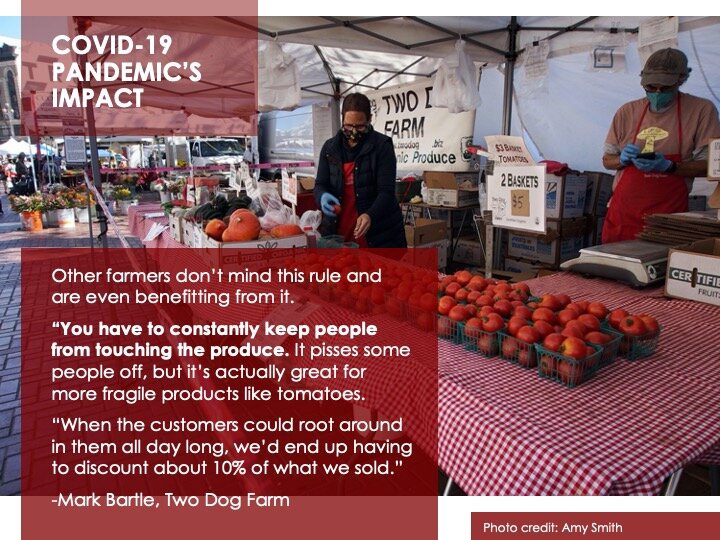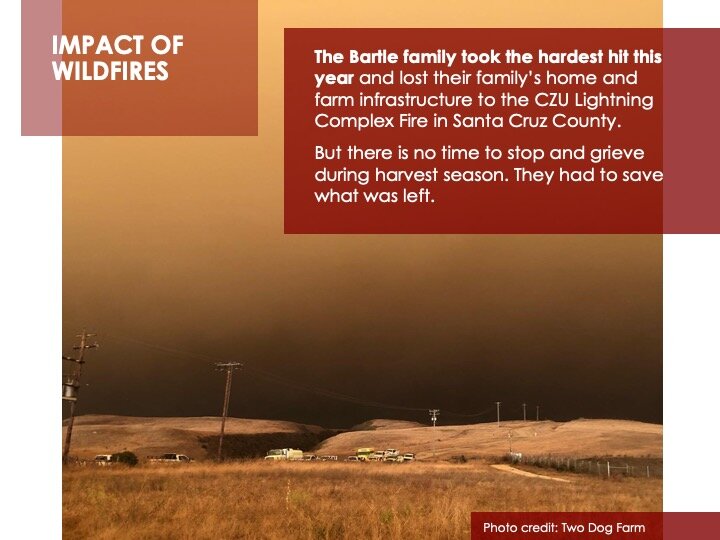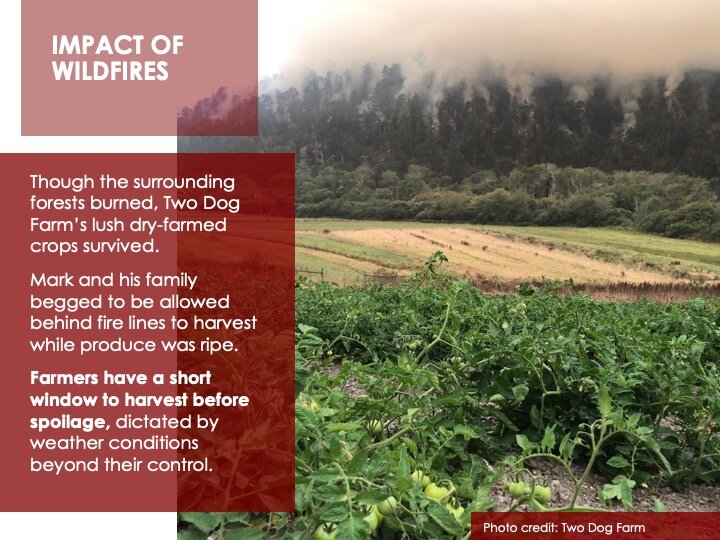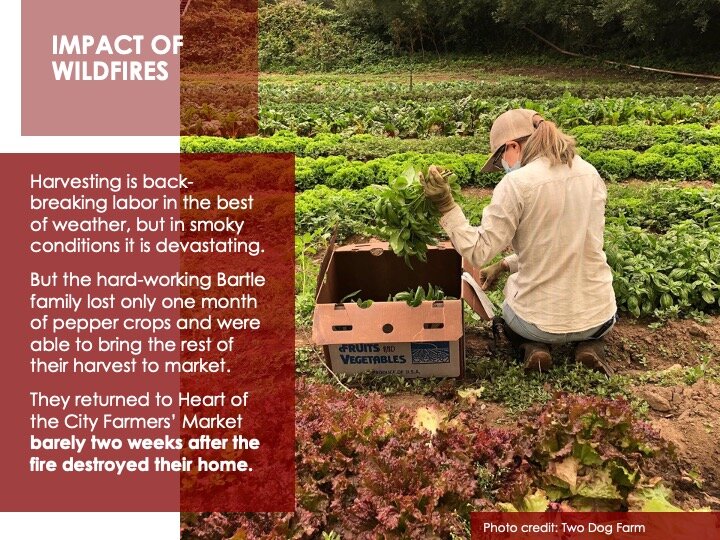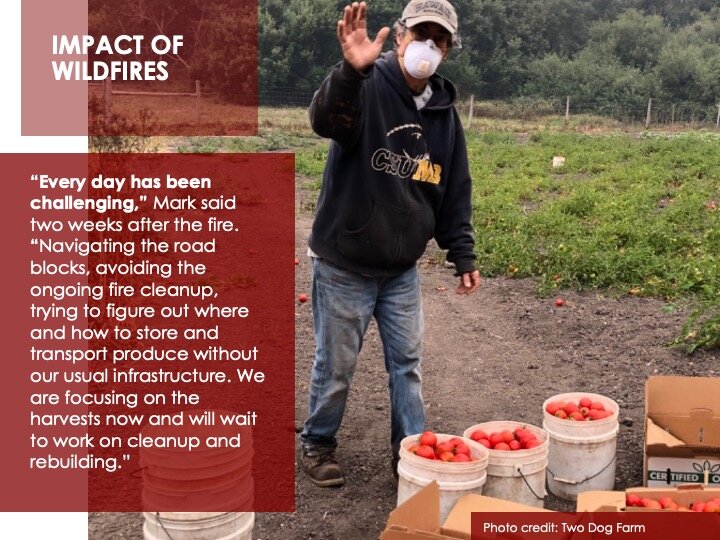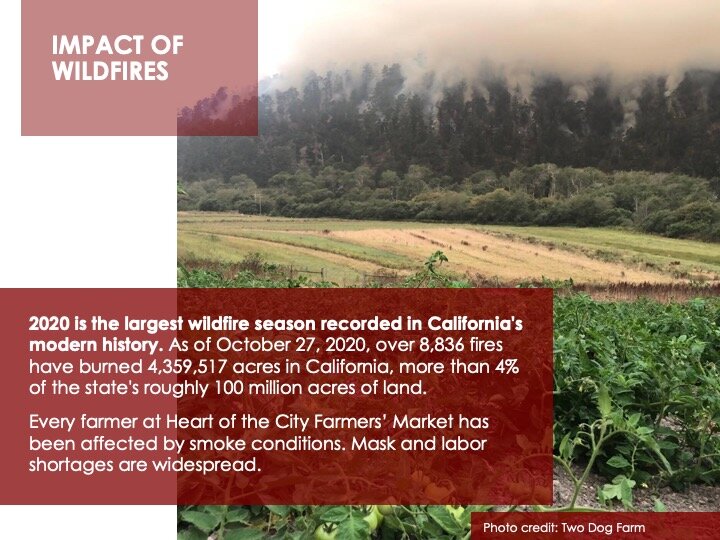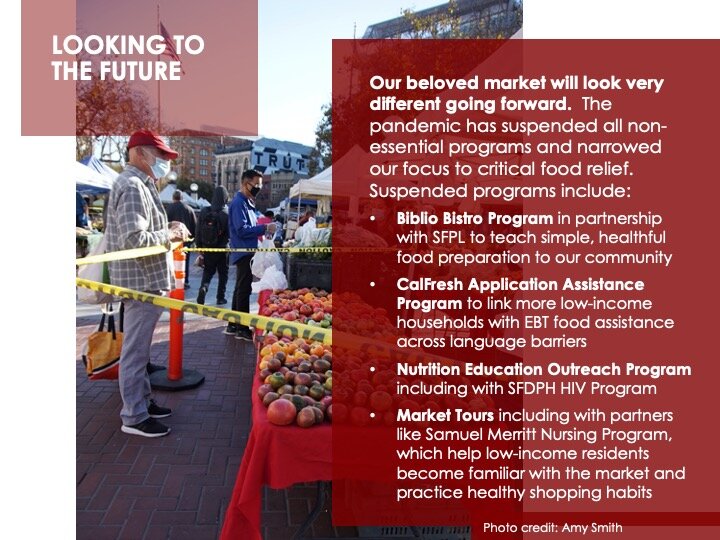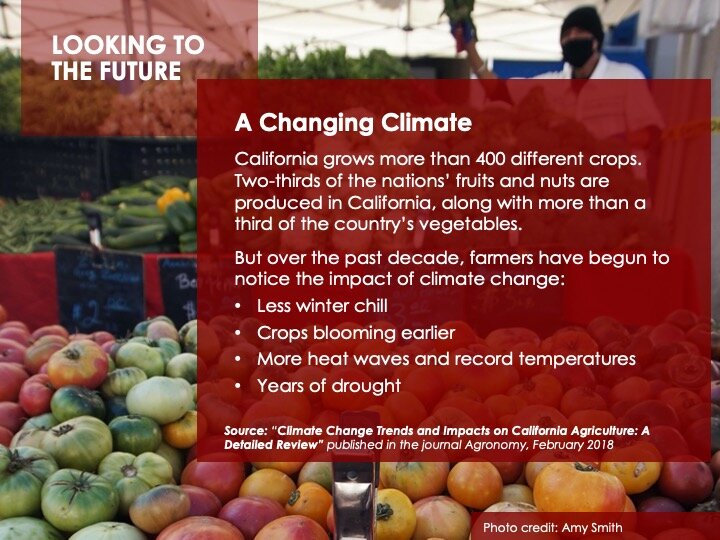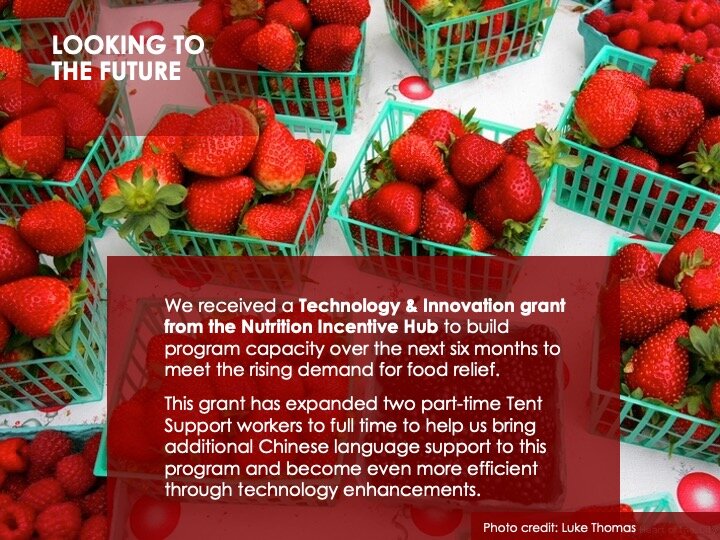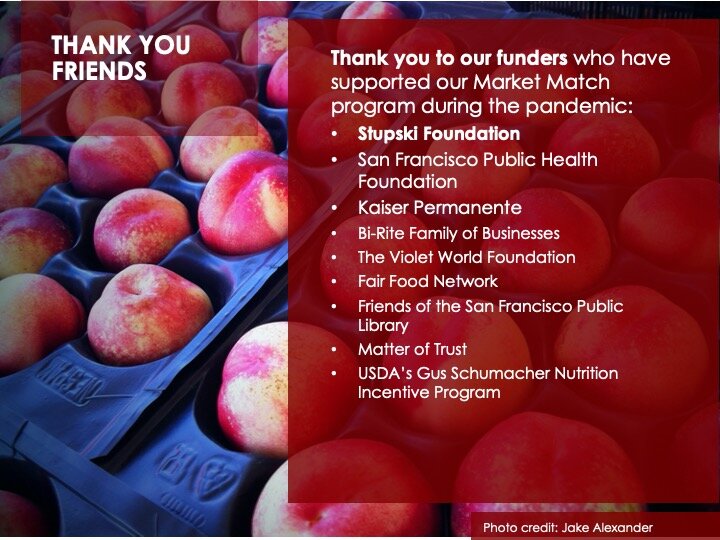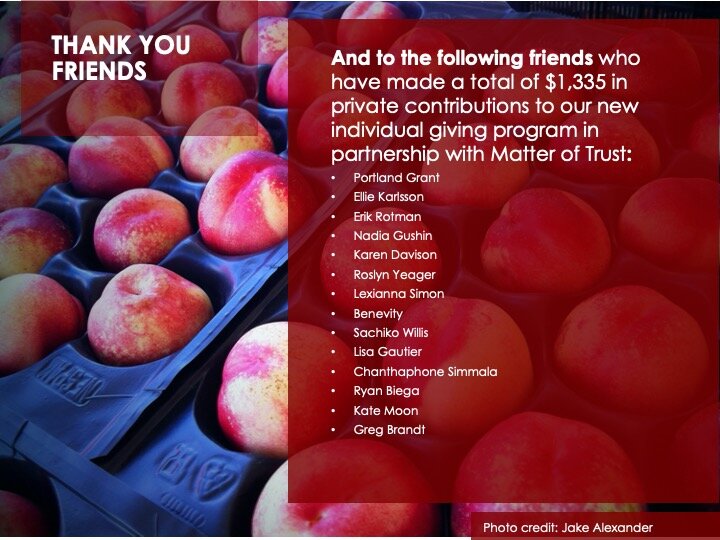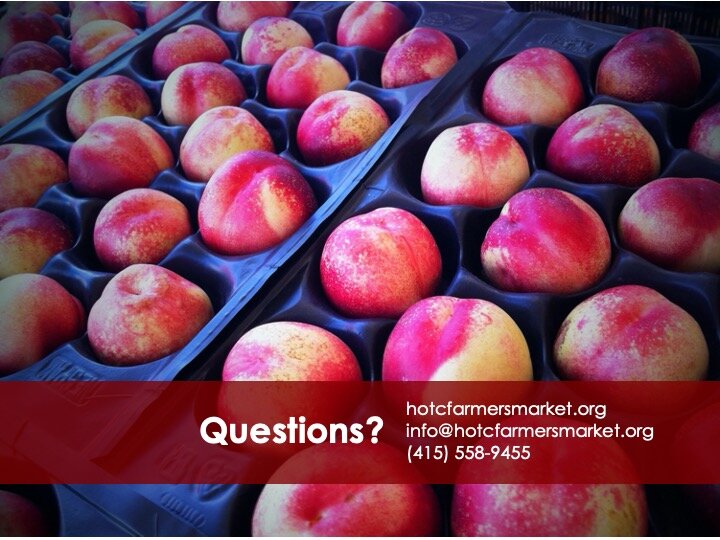San Francisco Public Library PrESENTS:
“The Future of Heart of the City Farmers’ Market”
November 6, 2020
Presentation Transcript
Lia Hillman, San Francisco Public Library: “…I’m going to head over now to the Executive Director of Heart of the City Farmers’ Market, Kate Creps.”
Kate Creps, Heart of the City Farmers’ Market: “Hi everybody. We are really touched so many people registered today to hear about Heart of the City Farmers’ Market and how we’ve been affected by the pandemic and wildfire smoke. Thank you for joining us. It’s a stressful week for everyone but thank you, we appreciate it. I wish I could meet you all in person but it’s a different world now. And thank you so much to Lia and her team for this chance to connect with you over Zoom. It’s very valuable to us to be able to share our story like this.
“My name is Kate Creps, I’m the Executive Director of Heart of the City Farmers’ Market. I’ve been working to promote food justice and community development for 15 years and I’ve been working here in the Tenderloin neighborhood for 12 years.
“I joined Heart of the City Farmers’ Market in 2010 and at that time, I took our non-profit and shifted its focus to building community partnerships to create a strong network with the social service providers that are already working on the ground here. Our goal is to increase food access for a community that faces a lot of food access challenges. There isn’t a full-service supermarket serving this community and unfortunately during the pandemic that makes it very problematic for low-income families to access healthy food. We now have over 50 community partners, we’re proud of that, and our food access programs have grown to 10 times the size they were in 2010. So the sky’s the limit for us especially with the amount of need we are serving on the ground right now.
“I’m also joined today by Steve Pulliam, our amazing Market Manager. Steve would you mind making some noise so everyone sees you?”
Steve Pulliam, Heart of the City Farmers’ Market: “Hello everybody, thank you for having me.”
Kate Creps: “And our Assistant Manager Abby Winship Hoyos. Abby can you say hello?”
Abby Winship Hoyos, Heart of the City Farmers’ Market: “Hi.”
Kate Creps: “Both Steve and Abby are neighborhood residents and were shoppers at the market first before they joined the organization so they have a lot of love for the market, we really appreciate them. You might have seen us bouncing around the market over the last five to ten years. Our job is to keep all of the moving parts running on the back end. The three of us are responsible for the non-profit organization operations to make sure everything runs smoothly.
“So a lot has changed in the world since March 2020 and that's certainly the case here at Heart of the City Farmers Market. We've had a lot of impacts that have changed what the farmers market is going to be going forward. We thought that this would be a great way to communicate some of that to you, the programs that unfortunately we've had to suspend, possibly indefinitely, and some of our new focuses and where we're going to take the market from here.
Kate Creps: “I really love this picture it's from the 80s. This is what our farmers market used to look like. We started in 1981 and we're really proud because we're the only independent, farmer operated non-profit farmers market… since 1981, but we're still the only one in San Francisco.
Kate Creps: “Here’s a poster from our 10th anniversary that is hanging in our office. What we really like is that we center the voices of farmers because we're independent and farmer-operated, we really listen to the farmers and they listen to their customers on the ground. That enables us, because we keep our staff team so small, to really respond to the needs of the community around us.”
Kate Creps: “We're still open after almost 40 years every Wednesday and Sunday, rain or shine, including holidays, at the United Nations Plaza above Civic Center BART station. It’s really important to us that we are an accessible source of food so we almost never close. We’re pretty much working year-round, rain or shine, in all conditions.
Kate Creps: “The market was started on June 14, 1981, because the neighborhood didn't have a source of fresh produce. It's an extremely low-income neighborhood, a lot of families are living here, but to this day it lacks an affordable supermarket for its residents. It does have some grocery stores but but the majority of those grocery stores do not sell fresh produce and as you can see from this picture, down on the right, there are a lot of unhealthy options. Like the sign here advertising to use your EBT card for unhealthy food [candy.] So our market was created to fill that gap and to say “Hey, we're here, you can get fruits and vegetables and we can make it affordable or do what we can to try to make it so that your family can afford it.”
Kate Creps: “Today over 80 farmers and small food businesses bring a colorful oasis of healthy food from local farms, about one to three hours away, down to the heart of the city to help the struggling community. You can see we put our vendor map here. It's a little changed now, we just haven't updated it after the pandemic.
Kate Creps: “We're proud to say that our farmers grow what they sell. That's the great thing about a farmers’ market.”
Kate Creps: “In California, what's called a California Certified Farmer's Market means that every farmer participating at it gets one of these Certified Producer Certificates from the Agricultural Commissioner of the county in which they grow their produce. And that means the Agricultural Commissioner come out to their farm and inspected to ensure that these products are actually growing in the fields. And then we can see on this certificate when we expect to see the product and about how much we can expect to see. You'll see that at the farmers’ market every farmer is required to post this and so we inspect that and make sure that everything on the table is grown by that farm. That means that we can promise our customers that every dollar spent with us supports local agriculture.”
Kate Creps: “Choosing to shop at farmers’ markets supports sustainable, local, hardworking small farm families like this one. This is Poli and Silvia Yerena. We help customers feel empowered to really change the food system with their purchase. Use your dollar to vote to make the food system stronger and more sustainable.
Kate Creps: “Heart of the City Farmers’ Market is uniquely independent. We obtained a 501c4 nonprofit designation in the 1980s and we are governed by a Board of Directors made up of five farmers out of the member farmers that participate with us. All of the participating farmers elect representative board members to sit on our board. We call them our Farmer Advisory Board which means everything that Steve, Abby, and I do is run by those farmers to make sure that it is meeting the the needs of the farmers that we serve and also aligns with the mission that that guides us.
“And those five farmers elect community board members, members of the community who either work or live in the community. They help us gauge the needs of the people who live here.”
Kate Creps: “Here is Tony Mellow, I think a lot of you probably know him. He has been selling in this spot since the very first day in 1981 and he has served on our board multiple times. He’s a friend to most of the farmers in the market and he's been elected often to serve over the last 20 years. He has just been invaluable to help us make sure that we're really centering the voices of farmers and listening to them when we run this organization.
“He likes to say that he remembers how long the lines were on the first day that we opened, because it was so critical to get food into this community, that before the sun even came up on our first day people were standing in line trying to get to this produce. And a lot of the reason for that is back then in 1981 the neighborhood was dominated by liquor stores fast foods. There wasn't a lot of healthy food options or full-service food options especially culturally-appropriate food options and the market filled that gap.
“We're really grateful to the American Friends Service Committee, the Quaker organization that is over on 9th Street, and the Market Street Association because those were the two organizations that helped start this market and then they chose to turn it over to be run by its member farmers. It's a pretty cool story.
“The market has changed over the years but the community's food access challenges have really remain almost the same. There are a lot of good people on the ground working right now and a lot of exciting things happening but there are still enormous hurdles to get food where it needs to go. So the oasis of fresh food that the farmers’ market brings is just as crucial today.”
Kate Creps: “This is me and my daughter. Our small staff team runs one of the largest farmer's market food access programs in the nation, and as I said, we're 10 times the size we were in 2010. We work really hard to keep overhead costs as low as possible at our market and we employ only three full-time workers without grant support or special projects that we're able to go out and get additional funding for. That’s me, Steve, and Abby, it's the inner echelon of our market and, as you'll see later in the presentation, we flex, we get larger as we're able to get more grant support but then we fall back to our three when we don't have enough money to keep that going.
“I have been with the market since 2010, Steve has been with the market since 2012, and Abby's been with the market since 2015. So we've all been working for a long time on the ground. Of course there are a lot more people in this community have been here longer but we feel like we've been here long enough now to, hitting the new challenges that we're up against, we're ready to fight. We've established a strong team and we're moving forward.
Kate Creps: “Our farmers market is a non-profit and that means we have a mission statement that the farmers came up with. Our mission is to support and sustain small- and medium-sized growers and make fresh food accessible for low-income customers who struggle to afford healthy food in a City with the highest cost of living in the nation.”
“So let's focus on the two parts of our mission. The first part is to support and sustain small and medium-sized growers. This is how our organization realizes that mission:
We minimize operating costs to keep participating fees as low as possible for farmers. I touched on that a little bit but that's really important for us.
Our flexible attendance policy means that vendors only pay their stall fees when they can participate and have crops growing to sell. So farmers are at the mercy of the seasons and anything else you want to throw at them but our farmers’ market has been built since 1981 to roll with those punches with them, which means if it rained on the strawberry crops in the morning and they're unable to pick it because they will spoil if they go into a basket and they can't come, we don't charge them we just save their spot and wait until they're ready to come back. It makes it a little challenging for us but that's part of small agriculture and we're here to roll with those punches too.
Our fundraising efforts directly benefit farmers. We're proud to say that we've raised $650,000 just in 2020 that was passed directly to low-income customers and then they used that money to buy healthy food from vendors. So that's a big part of our mission, to just get money and even though it doesn't directly benefit our organization, we pass it along to the low-income customers, essentially helping both parts of our mission through that effort.
Our nutrition education outreach program and our partnerships with over 50 community social service providers, hospitals, and schools helps link customers in need with farmers. Farmers are so busy they don't have time to do their own marketing and outreach, especially not our farmers because we really focus on small farmers and many of them have language barriers. Many of them have time to get into the office and really do the marketing. We help to fill that gap for them and connect them with new customers that we've brought down to our market.
And we prioritize equity and access for farmers, which is really important, by providing trainings and other assistance that levels the playing field across technology and language barriers.
Kate Creps: “Let's look at the next part of our mission, which is to make fresh food accessible for low-income customers. The community we serve faces enormous food challenges. The main reason for this is that there isn't an affordable, full-service supermarket within walking distance and the neighborhood is dominated by unhealthy food options like liquor stores and fast foods. There have been a lot of efforts recently and more energy around getting a supermarket in the neighborhood. TNDC has been doing some amazing work around that. I have not heard the latest update, the last I heard was in 2017, but I know it’s quite challenging. The community now is focusing on working with local grocery stores to convert to sell more healthy food options. But we’re here to make sure that there are culturally appropriate produce items and that there's a wide selection of them so that we can meet all the needs of one of the most diverse neighborhoods in the nation.
“Our food access programs include purchasing assistance programs nutrition, education outreach, etc. They work to connect low-income households with the healthy food that farmers bring down to our markets.
“Our multicultural competency efforts really strive to make this healthy food accessible across cultural and language barriers. We're proud to say that over 50% of our leadership team are People of Color and we require racial equity training for all staff. We want to make sure that we are meeting the needs of this diverse community.
“And then 50% of our farmers – more than that, the number fluctuates but we thought it was safe to say 50% – speak a language other than English at home and that means that they are able to offer really diverse and culturally appropriate selection of healthy food for this community.”
Kate Creps: “This is our market information tent which looks a little different now. We used to have one tent, we’ve expanded to two now. And you can see our amazing employee, Yong, serving in her full PPE [Personal Protective Equipment] now.
“We’re proud to say that we provide $1.5 million dollars in food assistance a year. That is counting the number of tokens and vouchers that go out from our information tent and then are spent with farmers for healthy food. We work to increase access to fresh produce for an extremely low-income neighborhood dominated by liquor stores and fast foods. And, as I said, we distribute $1.5 million annually to customers to purchase it.
Kate Creps: “In the extremely low-income neighborhoods we serve that surround the market and Civic Center, specifically the Tenderloin, people are twice as likely to live in poverty than elsewhere in the city and access to healthy food is limited because of the issues we have bringing a full-service supermarket to the neighborhood. And the community's food insecurity has increased significantly due to the COVID-19 pandemic. We've heard that from most of the partners that we work with. This is compounded by reductions to public transit and the challenges of social distancing on crowded streets because that's left many residents stranded without access to healthy food. So it is helpful that Heart of the City Farmers’ Market shows up in the middle of this community two times a week to bring healthy food to it.
“Here's some food for thought which I got from a great article that was written called “On the Front Lines Bringing Healthy Food Options to the Tenderloin.” This was written about the Healthy Corner Store Coalition by Shermine Turtine from Local News Matters. I want to run through some of these statistics about the Tenderloin that keep us pointed in the right direction and making sure that we're meeting the needs of this community:
The Tenderloin neighborhood has an older and more ethnically-diverse population than San Francisco as a whole.
The neighborhood is home to a greater percentage of Black/African American residents.
Roughly a third of the residents speak English less than very well, so language barriers are huge here to knowing how to access food and how to access food assistance to purchase that food.
The Tenderloin is home to a significant portion of the City's homeless population and, of those who are housed, roughly a third pay 50% or more of their income and rent. Considering how expensive food and utilities and medicine is in the most expensive place to live in the nation, that's a really scary statistic.”
Kate Creps: “So we're going to move now into what the pandemic has done. Participation in Heart of the City Farmers’ Markets’ food access program, which was already the largest in California and one of the three largest in the nation before the pandemic hit, has increased 47% and we now serve on average about 1,400 CalFresh EBT customers each market day. For people who don't know what CalFresh EBT is, that’s the name for what was formerly known as food stamps, the card that families and households have now to make sure that they can access critical food.
“Over 6,000 unduplicated CalFresh EBT customers have accessed our Market Match program and that’s just since Shelter in Place began in March 2020. So that’s enormous, I’ve never heard of a farmers’ market that has been forced to rise to challenges like this. It’s a big testament to Steve and Abby on the ground that they’ve been able to weather what they have over the last six months.
“Over 2,000 new participants have joined our Market Match program during that period. We'll explain more about what the Market Match program is in future slides.”
Kate Creps: “Heart of the City Farmers’ Market – and I’m just so proud of this – has distributed $502,000 in free food vouchers and token to low-income residents just since Shelter in Place began in March. That’s funded by our Market Match program and the Healthy Food Purchasing Supplement program, which is run by the San Francisco Public Health Foundation funded by revenue from the San Francisco soda tax. $474,000 of this food relief has been spent with farmers already. When you give out food relief in the form of vouchers for people to use, there’s always a concern about how much of it is going to “get lost in the couch cushions,” how much of it is not going to be spent. But at our market, 95% of it has been spent already and much of the remaining is not expired yet, so it might come back to us. That just really proves how critical this food is that people who are getting this money for food are spending it right away with small farmers.”
Kate Creps: “So now I would like to turn it over to Abby Winship Hoyos, she manages our information tent and holds together all the complicated moving parts of our food access program including distribution and redemption tracking for tokens and vouchers. I joke with Abby all the time that she's our information tent goddess and I bow down to her. She has kept this enormous program running through the chaos of the pandemic and helped us stabilize after we doubled in size in just six months. And that's saying a lot because we doubled in size the year before that. But I’ll let her explain more about that. It’s been really difficult to keep up with the neighborhood’s food security challenges but Abby never gives up because she just loves the market so deeply. She keeps us stable and strong. I’m really grateful for her. Abby, it’s all you.”
Abby Winship Hoyos: “Thanks Kate. I want to say good morning, welcome, and thanks to Lia Hillman in the Business, Science & Technology Center at the library. In the same vein how she said that the library has so many resources that people don't know about or don't know to take advantage of, I think our farmers’ market is not just a farmers’ market, we're so much more than that. And I'm glad that we have the chance to do this presentation today for people to learn more about who we are and what we're doing.
“So in order to make our very large food access programs work, we have our own currency system. This facilitates connecting low-income customers with the healthy foods sold at the market. We have tokens and vouchers which are provided at our information tent. There's four colors of tokens and vouchers that each have their own programs and restrictions.”
Abby Winship Hoyos: “The market information tent – now tents – are located on the west side of the UN Plaza close to the Simon Bolivar Statue on Hyde Street. There are three points of sale serving customers. Since the beginning of the pandemic, we went from one information tent to two information tents so that we could keep our tent support staff and our customers socially distanced.
“So there are three points of sale at the two tents. Two of those points of sale are serving one long line of customers and we’ll talk a little bit about why that line is so long, if people haven’t figured it out already. That line was moved because of the pandemic from going down the middle of the market to around the statue and around Hyde Street sometimes past that. But we are working on efforts to make that line wait time shorter.
“The third point of sale is a priority line for credit cards, debit cards, and our vouchers. When no one is waiting to use a credit or debit card or vouchers, that point of sale also serves the long main line.
Abby Winship Hoyos: “We do process credit cards. I know I still find people regularly who don’t realize that we also process credit cards at our market information tent. We don’t charge any fee to do that, the Heart of the City organization covers the processing fees for those. We do this for convenience because it keeps customers in the market. If someone says “Hey, where’s an ATM?” There’s always a change that they might go looking for an ATM and just not come back. So it keeps people in the market for convenience.
“It also levels the playing field among the different farmers that may have language or technology barriers that make it inconvenient for them to swipe the cards at their own tent. It also can slow down the line if they’ve got a lot of customers. Having the tokens is just a very easy way for farmers to accept credit cards without having to stop and process the transaction.
Abby Winship Hoyos: “We also have our own five dollar voucher that is an equivalent of the green credit card tokens. We partner with local service social service providers, nonprofits, schools, and some hospitals to provide these five dollar vouchers to their clients. These can be exchanged for the green tokens at the information tent and this is a way to enable organizations to provide gifts or rewards or participation incentives if they're doing a nutrition education workshop and another great way to infuse vulnerable low-income communities with healthy food.
“Both the green tokens and the black vouchers are eligible for any item sold in the farmer's market.”
Abby Winship Hoyos: “Our largest program by far is the EBT CalFresh program. We're one of the largest farmers’ market SNAP programs in California and we have confirmation from friends in USDA that we're in the top three in the nation. Who's ahead of us, I can't imagine who it would be, but that information is not publicly available.
“We've gone from accepting $14 on the market's very first day in June 1981 to, in the past 12 months alone, we've processed over $850,000 dollars in EBT sales. On this slide you can see the EBT card and we also process the black-and-white Pandemic EBT card that was given to families in California whose children participate in free lunch programs or families who already have CalFresh EBT. Both of those cards purchase the yellow one-dollar token that you see on this slide.”
Abby Winship Hoyos: “The EBT program really grew when we became a Market Match partner at Heart of the City Farmers’ Market. EBT customers get an extra five dollars free for fruits and vegetables every market day that they come ot the market, when they spend $5 or more with their EBT card. That’s funded by the Gus Schumacher Nutrition Incentive Program. And I’m so glad that we get to do that, it is a real draw for the customers to come to the market and it’s those dollars that are really being spent on fruits and vegetables in the market.
“We’re the largest incentive program in California and we’re a national model to encourage SNAP customers to spend their EBT benefits on healthy, locally-grown produce that supports small farmers in their community. For someone who cares a lot about local food and everyone eating healthy, I’m in heaven, I just can’t imagine better work out there. So I’m really appreciative of our customers and our farmers coming together in this special place at Heart of the City, where it all happens.
“Since we joined the California Market Match Consortium in 2015, we’ve distributed two million dollars in Market Match incentives to low-income customers.
“The major difference between regular CalFresh EBT dollars and the blue one-dollar Market Match tokens is that the yellow EBT tokens can be spent on any CalFresh eligible food at the market, so that would include fish, eggs, nuts, and honey as well as fruits and vegetables. And the blue ones are exclusively for fruits and vegetables. Those are federal restrictions for the EBT Dollar so that’s enforced at the market. I love that people have the flexibility to spend their EBT dollars on what they like and that the Market Match blue tokens are specifically for fruits and vegetables, so it really is a nutrition incentive.
“Kate mentioned that our program has doubled a couple times in the past couple of years. Last year, we had a very big change. Previously, SSI recipients – seniors and people with disabilities – were not eligible for CalFresh in California. Supposedly they had their food benefits built into their SSI benefits [amounting to only $8 a month.] That was changed by legislation and went into effect in June 2019, at which time we launched a program to help seniors and people with disabilities enroll in Calfresh who were not previously eligible and now they are eligible because of the SSI Cashout Reversal.
“We launched a CalFresh Application Assistance Program with funding from Stupski Foundation so that people could start the application process right at the farmers’ market. We had a captive audience to also tell about our programs and how they could use their CalFresh EBT card at farmers’ market once their application was approved. And we offered that application assistance in English, Spanish, Mandarin, and Cantonese.
“As a result of the SSI Cashout Reversal, EBT sales increased by 78% in the first month after the change. We went from our busiest days being like 500 customers a day, maybe 800 customers on a very busy full harvest day, to now regularly over 1,500 customers a day. So yes, significant growth in the past year. And that’s generated an additional $375,000 in EBT sales for farmers in the 12 months after that SSI Cashout Reversal went into effect.”
Abby Winship Hoyos: “This slide shows EBT sales over time. Ten years ago in 2009, we were processing a not insignificant amount of sales, just under $90,000 in that year. And growing with what was probably what should be typical for markets and also related to the work of partnering with social service organizations in the neighborhood, spreading the word about CalFresh being accepted at the farmers’ market.
“Then in 2015, there’s the first significant spike in growth. We go from $331,593 dollars our first year in the Market Match program, and we only started doing the Market Match program part way through that year, then we add to that $136,094. So a lot of food assistance growth in that year.
“2016, 2017, and 2018 were full years with CalFresh EBT and Market Match incentive, we would get more customers coming to the market as a result of Market Match. And then in 2019 you see a significant spike – that’s because of the SSI Cashout reversal paired with that. So in 2019 we did almost $670,000 paired with over $500,000 in Market Match incentives.
“We'll have to get everyone a larger screen to show the final numbers for next year because, in only the first nine months of 2020, we've already exceeded the amount of food relief distributed in 2019 by $115,000, hand-in-hand with $616,000 in EBT CalFresh and $615,000 in our Market Match program distribution.
“Low-income customers have made an astounding $850,000 dollars in CalFresh EBT purchases over the past 12 months and our EBT program is now ten times the size it was in 2009. It is believed to be the largest in the nation.”
Abby Winship Hoyos: “May 2020 alone was a very, very busy month. Heart of the City Farmers’ Market was able to distribute $168,911 dollars in food relief thanks to funding from the Healthy Food Purchasing Supplement grant that’s funded by the San Francisco soda tax, administered by the San Francisco Public Health Foundation. So that was all distributed in that month.
“Mind you that was two months into the pandemic customers were not as hesitant. We did see a dip during the first couple of months of the pandemic where customers were nervous and hesitant. As I mentioned, a lot of our customers are seniors so a lot of customers were staying home. But by May, the good summer foods are starting to come into season and people are wanting to shop at the market because there isn’t a supermarket within walking distance during the pandemic.”
Abby Winship Hoyos: “We were able to give that huge amount of assistance incentives to our customers and, as a result, our program almost crashed because we did not have enough tokens in our inventory in order to meet the demand for the tokens. At the same time, our token production factory was shut down due to the pandemic and had no known date that it was going to reopen. So we decided to act fast and launch a five dollar voucher system to keep the food relief flowing into our community and there's a very demonstrated to get incentives to our community. They were definitely there to collect it.”
Abby Winship Hoyos: “We also accept EatSF’s Vouchers for Veggies that are distributed through similar social service partner organizations and also at the WIC office. We accept the WIC Farmers’ Market Nutrition Program vouchers and Senior Farmers’ Market Nutrition Program vouchers. It seems as though the senior ones are not being distributed the same this year because of the pandemic, but for future years we will accept those. And also VeggieRx vouchers, the ones at the bottom, the green and white ones that are given with a program run by Fresh Approach that includes nutrition education.
“These partnerships link our farmers to food assistance programs that provide clients vouchers to buy produce and makes another way to expand food access for a vulnerable, low-income community.”
Kate Creps: “Thank you Abby, that was great. I do want to say that, as large as our EBT and Market Match programs are, our EatSF program is hovering around $300,000 a year that becomes much-needed income for our small farmers. So we’re really grateful to the EatSF team and Vouchers 4 Veggies for building that up from scratch. When they approached us it was such a small program and we had no idea it was going to become what it is now, but now it’s a national model for using fruits and vegetables as medicine and getting food into these communities of people who might be falling through the cracks and not be able to access fruits and vegetables otherwise. So we’re really grateful to Cissie Bonini and the EatSF team.”
Kate Creps: “So now we’re going to look at the COVID-19 pandemic’s impact specifically on our vendors. Get ready, it gets sad here.
“Most of our farmers have been with us for over two decades because of our unique mission to generate additional revenue for farmers through these equitable food access programs that we run. This is Matteo and Rosa DeSantis, they’ve been selling with us since 1984. They’ve been around for a long time, Rosa was a Board member when I joined the market in 2010 and has really helped us keep the market pointed in the right direction.
“But unfortunately this family suspended their participation at Heart of the City Farmers’ Market in March 2020 after more than 30 years due to the impact of the pandemic, especially high-risk health conditions faced by a lot of our senior farmers who have been selling for a long time and are having trouble finding younger generations to take over the farms because farming is such an incredibly difficult industry to keep sustainable in this modern world. They've said that's one of their problems and they're not alone.”
Kate Creps: “Unfortunately 52 vendors have reduced or suspended operations at Heart of the City Farmers’ Market due to the pandemic or around that the time of the pandemic. That’s reduced critical operating revenue for our nonprofit and programs. I just want to remind everybody that our nonprofit was built since 1981 to really roll with the punches that the farmers have to sustain, meaning that if farmers can't participate with us we don't charge them, we only charge them if they show up.
“Having so many farmers reduce or suspend operations all in one year has been the biggest challenge that our organization has faced yet.”
“I want to focus here on one of my favorite farms because it’s one of our smallest farms. This is Ken Phan and his family, one of the smallest farms at the market. They suspended operations fear of exposure for their family. For a lot of our small family farms, they're the only ones that work on the farm they're out in the fields picking, they're selling at the market, Ken brings his children to the market to play around him him because they're selling. So he was especially worried about the impact of the pandemic and virus exposure on his family.
“He suspended operations when the pandemic hit after March. We had a really amazing volunteer go around and do some interviews for us and we have brought some quotes into this presentation so you can hear directly from these farmers. This is Ken and he said: “I discounted, donated, gave away here and there. We took a loss for three months. No income, no nothing.”
“So just imagine, those of us who have a salary, all of a sudden you you take a hit – 25% of your salary is gone, I mean it’s not quite that because farming is not uniform like that, but still it’s a huge hit for a small family to take.
“And, we heard this a lot from the farmers that we spoke to, that they tried to apply for federal stimulus assistance but had trouble navigating the complicated system. There are a lot of language barriers and technology issues. When people are out in the field, they don't have time to be on their computers or standing in line trying to figure this out. He was not able to get federal assistance and was unable to withstand further loss, so he planted a new crop and returned to the market in June. So he says:“Income is starting to come back in, but there are not a lot of people working at the offices now. It’s really slowed down.”
“He says that his sales since returning to the market have fallen 25% from what we would normally expect at this time of year, and we know that that's going to continue falling as customer foot traffic slows with the winter. “It is what it is,” he said. “Last year was great and then this year, boom. The same thing that happened to me is probably happening to a lot of people.”
“Ken is such a sweet soul and he's recognizing that he's not the only one being impacted, but we're still really worried about his family in the future.”
Kate Creps: “52 Heart of the City Farmers’ Market vendors have reduced or suspended their operations which is so high considering we have 80 to 85 vendors regularly. These operations have been affected – suspended or reduced – directly as a result of the impacts of the pandemic or smoke. And when we added it up, 16 of them are now considered out of business in our records. We don't know, they might be coming back, we're trying to figure it out. I don't even think they know.
“You can see here I circled the ones in yellow who have reduced their operations from what we're used to seeing, that means that they couldn't find workers, they couldn't pick, they couldn't get out into the fields, smoke might have closed them down for for one reason or another.
“But then I've also circled in maroon/red here the ones that we just know, but don’t think that they will be returning.”
Kate Creps: “Unfortunately one of the biggest impacts on us is the closure of downtown offices and it's had an absolutely devastating impact because of where we're located. It's difficult to get to us unless you're working in the neighborhood or you live in the neighborhood, especially once public transit becomes problematic for many people with health conditions or fear about that.
“What that's done is it's changed the customer demographics of people shopping at our market, and we have a really fragile balance. We serve the low-income residents in the neighborhood but in order to keep the farmers returning because of making sufficient sales for their businesses to stay afloat, we need to supplement that with higher-income office workers. And with the closures of the downtown offices and not knowing when or if they're going to return, and also the statistics that we're seeing about how many are going exclusively remote in the future and how many businesses are shutting down, we're really nervous about the future balance of the demographics of the customers who shop at our market and having to really become resilient and figure out what the future is going to look like for us.
“Heart of the City Farmers’ Market’s nonprofit organization has lost $72,000 in expected or budgeted stall fee income due to the impacts of the pandemic and smoke on participation. You can see over here I compared the 2019 revenue to the 2020 revenue and we're losing around ten thousand dollars a month now, what we had budgeted and expected to come in and what is now actually coming in. And that’s not even the worst news.
“Our vendors have lost $140,000 just between March and September 2020 in expected credit card sales income. Abby explained that we do level the playing fields between our lowest grossing and our largest farmers by accepting credit card sales and eating the processing fee so that it doesn't cost anything for the customers to do that, but it also doesn't cost anything for the farmers to do that. We do that because a lot of the smallest farmers have language barriers and can't process Square on their on their phones.
Kate Creps: “So you can see here at the top, our expected 2019 sales. We usually will look at the year before to know what to expect this year. The sales are just so much lower than we expected and that results in a huge loss for the vendors who rely on this income to just make it through this pandemic.
“Unfortunately these losses were sustained during what's normally the busy season at the farmers market. We are a year-round farmers market and we're really proud of our mission that we will be reliable, we will be open rain or shine, holidays, we're here. No all farmers will necessarily be here here, it’s up to them whether they choose to participate, but the market will be here and some farmers will be here to serve customers. We stayed open on Christmas Eve a few years ago and were surprised that over 90% of our expected farmers showed up, so the farmers really need places to sell and there’s such a diverse group of people in our neighborhood that there’s always people who need food access.
“We’re open, but we’re like an accordion – in the summer you can see everything’s growing and the market is larger with more farmers participating, then in the winter we go into a little bit of a hibernation mode just trying to make it through to the next bountiful season.
“All of these losses that I have talked about have been sustained during the busy summer season. So we’re pretty nervous about what this coming winter is going to look like as we go into this hibernation mode. We have a lot of efforts on the back end to make us strong and stable to go through it, but it's still a little scary for all of us. We’re worried about the market’s survival of course in the long run, although we're a strong team and we're moving it forward.
“But we’re really worried about the future livelihood of our remaining vendors. Some of them are just holding on, and we’re worried this winter might – we’re hoping it’s not the one – that puts some of these farmers out of business.”
Kate Creps: “I’m going to turn this over to Steve Pulliam, our Market Manager. He manages all ground operations, vendor relationships, and helps me with partner outreach. I think of Steve as our rock. The job and the need we serve can feel really overwhelming sometime, but his steady and comforting presence really helps the team stay pointed in the right direction and moving forward, even if progress just happens with baby steps. I also love that he’s a driving force for food justice in San Francisco. He also manages the community garden for an underserved neighborhood in Portrero Hill and teaches workshops about sustainability and nutrition education. We pulled him onto the team in 2012 because I was able to get a USDA Farmers’ Market Promotion Program grant which helped us launch community workshops for the very first time. His ability to connect with the community and really get people excited about food justice and sustainability helped our EBT program participation jump 37% in just one year. His heart is huge and I’m sure if you know him, you love him.
“I’ll turn this over to him now, he’s going to explain how the pandemic and smoke has affected our vendors and ground operations.”
Steve Pulliam: “Okay, thank you Kate, you make me feel pretty good about myself. And thank you Lia and the library for having us. Before I get started with the presentation, I just wanted to make a point that, like we’ve all been impacted by the pandemic and the wildfires individually, there are a lot of stories that we’re not going to include in this presentation. A lot of farmers that weren't able to survive and make it through this.
“There is Bahcivan farms, Hasan realized that he was the – as Kate talked about Ken Phan – he’s the grower, he’s the harvester, he works the markets, and his family realized after coming to the market a few times that if something was to happen to him it would devastate the farm and it would devastate the family. So they decided not to come back after a while.
“There is Vang’s Farm, who called us and said “Hey, we can come on Sundays but we can’t come during the week on Wednesdays because we’ve got to homeschool our kids.” You know, distance learning. And they came for a few markets a didn’t realize that was even too much work for them, trying to make sure their kids were getting their education and trying to work the farm and come and sell at the market. It proved to be too difficult for them so they halted coming to the market
“We even had one farmer who decided not to come because she didn't feel comfortable wearing a mask all day at the market, so she wasn't able to come back.
“So there's lots of those stories out there. It’s been an incredible impact on our farmers and I just wanted to give a voice to some of those guys.
“We can start with the slides here, I’m happy to start with Yerena Farms, one of my favorites, I love their story. If you ever come to the market you want to see and meet them, they’re one of the sweetest families you’ll ever meet. I love their story, he started out as a picker and ended up having a dream of starting his own farm and made it happen. He ended up growing organic strawberries and now winning awards for his strawberries, so I’m a big fan of theirs. I’m happy to start with them.”
“Our farm has been through a lot including an earthquake, recession, and fires in previous years, but we've never been through anything like what we're experiencing now with the pandemic,” says Poli Yerena.
“Poli is currently on our Board and has been farming for over 44 years. His family bring organic strawberries, blackberries, raspberries, tomatoes, and vegetables to the market from Watsonville.
Steve Pulliam: “His family’s drive home usually takes about three hours. Since the pandemic has started, that commute time has been cut in half. That’s pretty much the only good news for an otherwise brutal year. But I will say the Yerena family did have some more good news. Their son Alex, who we’ve seen grow up at the market, was married during the pandemic. So there is a little bit more good news for them.”
Steve Pulliam: “Harvesting in smoky conditions has been extremely difficult. The ashes have impacted Poli’s berries and tomatoes and you can sort of see the effect on the tomatoes in this slide.
“One of the biggest impacts has been the closure of restaurants who order in bulk. These small farmers have to use multiple ways of selling their produce and this has had a major effect on them. To make up for enormous financial losses, farmers like Poli have been finding other ways to sell such as CSA box programs.
“Developing a CSA model or allowing for drive to pick up is not really possible at our market due to parking challenges for our customers. You can see that slide is a picture of the parking lot across the street at the library. Closures of local shelters due to virus transmission resulted in the conversion of our only available customer parking on Fulton Street to safe sleeping sites for our unhoused neighbors in order to create safe shelter for this vulnerable population.
Steve Pulliam: “I would like to say that, before they created that safe site, there was still a tent city across the street, an impromptu sort of tent city. The tents were piled up on top of each other, no social distancing, no hand washing stations, none of the facilities that were needed. So I applaud the City for actually organizing this and making sure there was a distance between the tents and providing facilities and hand washing stations and food and that kind of stuff. I thought it was long overdue and I was happy to see it.
“Unfortunately, it did affect our farmers and their sales, but I do applaud the city for that.
Steve Pulliam: “Heart of the City Farmers’ Market already spends 20% of its annual operating budget on private security due to the challenges faced by our community. But a rapid increase in mental health and other incidents in the Civic Center as a result of the pandemic has overwhelmed our team and forced us to appeal for help to keep the market safe.
“The Civic Center Community Benefit District came to our aid and helped us with some temporary security, especially these guys from Urban Alchemy who continue to “Transform People and Communities with Love and Respect” during the pandemic’s challenges. I want to give a special shout out to Urban Alchemy also because they were helping us out before the pandemic started, they were a Godsend for us, helping out our security team and cleaning up and doing all the things to help our market become a safe and comfortable place to work.
“And we sort of lost them when the pandemic started because they were in demand all over the City, but we just recently got them back and I’m just happy to have them back. Thank you guys.”
Steve Pulliam: “The negative impact of losing Fulton Street has caused a steep decline in customer foot traffic. “Sales are low. There's no parking and it makes it hard to stop by. A lot of people don't want to come anymore, that's the bottom line. Older people can't walk too much so it's important for this market to have parking,” says David Medrano from Medrano's Flowers
Steve Pulliam: “Quickly about this this vendor, they sort of got a soft spot in my heart because Khan with Pak Foods started out as a seller for vendor here he had a dream of starting his own business. He started bringing us food in to taste and we helped him along to start his business, especially Kate, so I feel a special affinity for him because he started his business, he thrived here, and he expanded to other markets. And now they’re suffering so I’m really hoping they can get through this rough time and get back to fulfilling their dream.
“Sales plummeted when office workers left the neighborhood. Our small family-owned prepared food businesses are barely hanging on. Eight of them have gone out of business since March. The remaining owes nearly $15,000 in loans for stall fees.
“And last quarter the health department raised permit feed. Not the best of timing there. So again our vendors are really suffering right now, probably the hardest hit amongst our vendors.”
Steve Pulliam: “We've noticed in our market that there's a lot less foot traffic,” says Muz Afzal of M. A. Farms. “We’ve seen a reduction of about 50% in sales. Farmers’ markets are the way we sell our produce. We’re still producing the same amount of fruit and stuff in storage is going bad because things aren’t moving so quick.”
“You know those trees don’t stop producing during pandemics so that food has to go somewhere. They had issues finding workers when COVID hit, a lot of the workers didn’t come to work and a lot of them were stuck outside the country due to the border shutdown.
“So it was Muz, his dad, and his sisters farming for the first three months of the season. And you know, with Muz, he’s actually just graduated from medical school and he’s out there helping his family on the farm. These farmers are incredible, some of their families just really blow me away with the way they take care of each other. He’s going to be a doctor and here he is struggling, helping his father pick fruit out in the field. That’s incredible.”
Steve Pulliam: Sean Garrone is a board member whose family helped to create Heart of the City Farmers’ Market in 1981. Far West Fungi’s stores in the Ferry Building and Santa Crus were closed temporarily due to the pandemic. I believe that their store at the Ferry Building is back open.“Most of our other farmers markets have been busier, we even saw increased sales at some venues because we supply supermarkets and people are cooking at home more.”
“But sales have reduced at the Heart of the City Farmers’ Market. Most of their markets are, you know, the customer base is a little more affluent than it is here in the Tenderloin. Most of this neighborhood consists primarily of SROs or one room dwellings with a shared bathroom and kitchen facilities. And this lack of kitchen access is a major factor in creating barriers to healthy eating, especially now.
Steve Pulliam: “One of the biggest impacts for these farmers has been the fact that they've had to increase staff in order to comply with the new regulations. I would say most of our farmers – more than half – have had to almost double the number of people they’ve had to staff in order to comply with the regulations and get the food to the customers. At same time their sales are decreasing, being cut so dramatically, you can imagine how their bottom line is is suffering.
“Heart of the City Farmers’ Market in May has made changes to our rules and regulations to keep customers as safe as possible at the market following the San Francisco Public Health Directive for farmers’ markets released in May 2020. The new regulations include PPE for all workers, hand washing stations, enforcing customer capacity limits, expanding to two information tents to help with social distancing, no-touch procedures for tent transactions, additional pre-purchasing options.
“No-touch procedures for produce purchasing has had a major effect on the farmers. Farmers report sales have reduced due to no-touch regulations. They complain that in grocery stores, you can touch produce, in other markets, you can touch produce, but here we’re not allowing you to. Recently we have adjusted our protocol slightly to allow customers to pick produce if the farmer supplies them with a glove or a clean bag that they can use to touch produce, so that our farmers aren’t suffering from competition from grocery stores in the other markets.”
Steve Pulliam: “Extra caution is needed to navigate racial equity issues as new rules are communicated across multiple language barriers. We try to put signs up in front of all the stands all over the market to inform people of our safety protocols in multiple languages, because we do have a quite a diverse customer base.
Steve Pulliam: Other farmers don't mind this rule and are even benefiting from it. This quote from Mark here: “You have to constantly keep people from touching the produce. It pisses some people off but it’s actually great for more fragile products like tomatoes. When customers would root around in them all day long, we’d end up having to discount about 10% of what we sold.”
Steve Pulliam: “I think that Mark's sort of unique in that respect, he's definitely in the minority because of the specialty items that he sells. People know their dry-farmed tomatoes are some of the best they've ever eaten. I can vouch for that. If you make some marinara or tomato sauce with those tomatoes, people will swear you put sugar in them, they're that sweet and delicious. So people know what they’ve getting when they go to his stand. Not to not give him credit for his great greens and lettuces.”
Steve Pulliam: “The Bartle family unfortunately took the hardest hit this year and lost their family's home and farm infrastructure to the fire in Santa Cruz County. But there is no time to stop and grieve during harvest season, they had to save what was left. Though the surrounding forest burned, Two Dog Farms’ lush dry-farmed crops survived.
Steve Pulliam: “Mark and his family begged to be allowed behind fire lines to harvest while produce was ripe. You know farmers have a short window to harvest before spoilage, so they have to get in there and harvest even though the conditions might not be advantageous to them being out there. Harvesting is back breaking labor. These guys are getting out there and even though they have a mask, you know you can walk through the City with a mask and you know how much it can affect your breathing and these guys are doing hard physical labor out there in the fields. And wearing a mask still isn't going to totally protect them from having to breathe in some of that smoke. But their livelihood depends on it so they have to do what they have to do.
Steve Pulliam: “Every day has been challenging,” Mark said two weeks after the fire. “Navigating the roadblocks, ongoing fire cleanup, trying to figure out where and how to store produce without our usual infrastructure. We are focusing on the harvest now. We'll wait to work on cleanup and rebuilding.”
“Like all small farmers, the money his family makes from this year's crops will be used to plant next year. So far customers have donated over $33,000 on GoFundMe to keep his operations stable as they recover and rebuild. “We have been very encouraged by the love and generosity we have seen from everyone,” Mark said.
“The latest with the Bartle family is they are looking into purchasing a trailer so that they can live in it until they’ve able to get their house rebuilt. So many homes were damaged during the fires that they’re thinking, three or four years down the road, they might not even be ready to rebuild yet because the construction crews are slammed right now. So hopefully they can get their house rebuilt sooner rather than later. But right now, they’re just looking into getting the trailer to hold them over until it does.”
Steve Pulliam: “This is the largest wildfire season recorded in California's modern history. More than 4% of the state's roughly 100 million acres of land burned. That's an incredible number. Every farmer at the Heart of the City Farmers’ Market has been affected by smoke conditions. Mask and labor shortages are widespread.”
Kate Creps: “Okay, sorry to rush you through that Steve. That's such a sad story. We love Mark so much.”
Steve Pulliam: “Yes.”
Kate Creps: “So looking to the future. I’m going to take over the rest and close this out. Our beloved market is going to look very different going forward. The pandemic has suspended all non-essential programs – and this depends on your definition of essential – but we have designated these programs as non-essential so that we can focus on critical food relief.
“The suspended in programs include the Biblio Bistro program in partnership with the San Francisco Public Library, it’s an amazing program run by Lia that teaches simple and healthful food preparation for our community.
“We’ve also suspended the CalFresh Application Assistance Program that Abby talked about to link especially seniors and people with disabilities across language barriers with the EBT program.
“We’ve suspended our nutrition education outreach program, which as I said Steve helped us launch in 2012. That includes a partnership we had with San Francisco Department of Public Health HIV Program to get into local clinics to really encourage people to use fruits and vegetables as medicine to address their conditions and make sure that they have the money they need to do that.
“And then we've also suspended all market tours including with partners like Samuel Merritt Nursing Program, programs like that help low-income residents become more familiar with the market and practice healthy shopping habits. It's important to us to demystify farmers’ markets, sometimes people can think farmers’ markets are only accessible to people with higher incomes, as you know it's a very white-dominated industry. We really want to get people to come to the market, meet the farmers, get to know us as a team, and see that we're just part of your community and you're a part of this market. These tours really help us connect people in that way.”
Kate Creps: “Our new Friday farmers’ market was also a casualty of the pandemic. We started that market in 2019 to bring additional food access to the neighborhood. As we said, there's no supermarket here so it's important to bring this fresh food in as many days as we can. The new market day grew rapidly, we're really proud to say that just in the first year we grew to have the third highest EBT sales of all 30 farmers’ markets in San Francisco behind only our Wednesday and Sunday markets, which considering those markets are 40 years old we were doing pretty well. Although it’s incredibly hard to start and incubate a new market now and it was not going to become a Wednesday or Sunday market anytime soon.
“But we lost over a hundred thousand dollars in City sponsorships for that market and we’re just unable to keep it open due to the pandemic. We have now closed that and we think, are nearly confident, it’s permanently closed.
Kate Creps: “I also want to address here very quickly that we’re moving into a changing climate – well, we’re in the middle of watching the climate change around us. California grows more than 400 different crops, two-thirds of the nation’s fruits and nuts are produced in California along with more than a third of the country’s vegetables.
“But over the past decade our farmers and all farmers in California have begun to notice the impact of climate change. Less winter chill, crops blooming earlier, more heat waves, record temperatures, years of drought… scientists say that agriculture will face much bigger and more severe challenges in the coming decades.
“There was a pretty amazing study in 2018 that examined 89 research papers and reports on climate change and that gave us some indication of what we're looking at in the future:
We have a lot of farmers coming from the Central Valley and more than 50% of the Central Valley is projected to be no longer suitable for growing crops like apricots, peaches, plums, and walnuts sometime around the middle of the century. And that's not that far away. That's projected to grow to 90% or more by the end of the century.
Crop yields are expected to fall for crops like almonds, table grapes, and cherries.
Summer heat waves are likely to take a toll on corn, rice, tomatoes, and sunflower crops.
Crops may also be plagued by pests, disease, and weeds due to rising average temperatures.
Decreased snowpack and changes in precipitation patterns will affect how these crops are grown.
“So not only are we facing challenges now, we have to be prepared to really get farmers through a lot of challenges in the future. Which is a problem for California, but as I said, California grows so much of the food for our country that it's a problem for the whole country.
“With a difficult winter ahead it's even more important for Heart of the City Farmers’ Market and our team to really continue our efforts to increase food access in order to support small farmers and give them the revenue they need to get through this challenging time. Our primary focus now is strengthening our purchasing programs like Market Match because these programs supplement sales for farmers and then strengthens them with the the money that they need to continue into the future.”
Kate Creps: “We want to give some good news: We got notification a couple of weeks ago that we got a Technology & Innovation Grant from Nutrition Incentive Hub, which is a project of the Fair Food Network, and we’re going to be able to build program capacity over the next six months to meet the rising demand for this food relief. The grant has expanded two part-time tent support workers to full time. We're really excited because it's going to help us bring Chinese language support to the back end of our programs so that we can become even more efficient and we're going to have a lot of new technology enhancements and try out some new things that keep us moving even faster. As Abby said, we really want to address the wait time to access our programs now and we have a lot of projects in the works for that.
“We remain ever grateful to our customers and community partners because that's what sustained this market for 40 years, so we know that with all these people behind us that we are going to preserve this oasis of fresh food and community in the heart of the city.”
Kate Creps: “I want to take some time to thank our friends. I really wanted to get through so that we had time to do this. Thank you to our funders who have supported Market Match through the pandemic.
“Stupski Foundation stepped up and in the first three months of the pandemic, where we didn’t even know if we were going to be able to keep the market open, they asked us what we needed and came forward with the revenue that we needed to supplement what we had lost to stay open and keep all of our staff team paid. They’re just such a good friend to us.
“The San Francisco Public Health Foundation, through their Healthy Food Purchasing Supplement grant, came forward with some additional pandemic funding for us that was ritical to keep us open. We have not closed since the pandemic began affecting us in March, we stayed open all the way through. Our Friday farmers’ market was the only casualty that we had.
“Kaiser Permanente really surprised us and came through with their annual sponsorship this year. We're so grateful to them, they've been supporting our Market Match program since 2015.
“And also Bi-Rite Family of Businesses, we just want to say thank you to them as well. We know that they are facing their own struggles over there but they came through with an annual sponsorship this year and actually increased it above last year. So thank you.
“Also the Violet World Foundation, Fair Food Network, Friends of the San Francisco Public Library (which is such a lovely surprise), Matter of Trust, and USDA’s Gus Schumacher Nutrition Incentive Program. Thank you all.”
Kate Creps: “We also want to thank some friends – this is very new for us, but Matter of Trust came forward and is acting as our fiscal intermediary to accept individual donations. This individual giving program is the first time Heart of the City Farmers’ Market has tried to do this and so far we’ve raised $1,335 from these customers. Oh my gosh you guys thank you, it’s very heartwarming, whenever something comes in we all cheer! We’re very grateful to you all and it’s a confirmation that the community loves us.”
“And then finally, I hope Amy's still on here, an extra special thank you to a new neighbor who just moved into the neighborhood: Amy Smith. She came forward and asked how can she help us get through the pandemic and I said, “Well, we're going to do this presentation…” and she took a camera around with her amazing skills, you have seen her photos throughout this presentation, and also she interviewed our farmers to ask them how the pandemic was affecting them and that's how we got these quotes to get into the pandemic’s impact. Thank you Amy.”
Kate Creps: “So we have very little time left but we have about five minutes to take some questions if there are any questions in the comments. You can go onto our website and this presentation is on our website now, you can go and click through the slides if you want to go a little bit slower and digest the information.
“You can also send me, Steve, and Abby questions at info@hotcfarmersmarket.org, we’re a small staff team so we’re very responsive. It just comes right to us. And then our phone number is down there too, our information line phone number, you can leave us a message.
“So thank you everybody, thank you friends, community, and thank you Lia and your team at San Francisco Public Library for giving us this platform to talk to everyone today.”
Lia Hillman: “You’re welcome, it’s our pleasure and honor to have you. So somebody was asking how does the public donate and Abby posted the link for your website, but maybe you want to just say that out loud.”
Kate Creps: “Sure, our website is hotcfarmersmarket.org and you'll see a Donation button in the main menu and that has a little bit more information about what your donation will go to support and a link there to donate online.
Lia Hillman: “So are there any more questions? I see that Anissa has posted that this program is available now on YouTube and she posted the link in case you want to go there as well to review it.”
“Alright, let's see, if you want to raise your hand with a question you're welcome to do that. We've got just a couple more minutes for the Heart of the City Farmers’ Market team to answer your questions.
Customer: “I’ll just say thank you that was really great and very sad too at the same time. I hope we all pull through this in another 40 years for your farmers’ market. 40 plus 40. And yes these people I’ve seen for decades, the same amount of time I’ve been here, the same people of the farmers’ market have been here. So thank you so much for sharing this and the information behind the scenes is always just so, so good.”
Kate Creps: “Thank you for your support.”
Abby Winship-Hoyos: “Kate, there's a question in the comments, it says “My neighborhood market is run by Pacific Coast Farmers’ Market Association. I did not realize that this was a separate organization. Can you talk about the different farmersr markets in the City? Is the Heart of the City market the only non-profit one?”
Kate Creps: “Well, we’re not the only non-profit, but we’re the only independent, farmer-operated non-profit and we’re completed separate from all other farmers’ markets.
“Pacific Coast Farmers’ Market Association is an umbrella organization that runs multiple farmers’ markets scattered throughour multiple counties, including San Francisco. So when you go to a farmers’ market there, the farmers’ market that you’re at is just one of a larger group. And Pacific Coast Farmers’ Market Association does do nutrition education outreach and other food access programs like we do through a separate 501c3 non-profit called Fresh Approach – I believe they are still affiliated, PCFMA is a 501c5. It’s a little different, we're not an association of markets because we want to be a little bit more grassroots and direct and have the farmers directly involved in the governing operations.
“There's also CUESA that runs the Ferry Plaza Farmers’ Market, the Center for Urban Education and Sustainable Agriculture, that also is a 501c3 nonprofit that does a lot of nutrition education outreach work and sustainability work but then also runs the farmers market as one of their projects of that non-profit. Unlike us, where our non-profit and our organization is the farmers market itself, the farmer's market is our main activity, that's what we grew out of and that's what we continue to be wrapped around.
“Alemany Farmers’ Market used to be an independent market. It’s the oldest farmers’ market in San Francisco, started in 1940 – some of our farmers say it was just people selling off the back of the truck at first, then the regulations got involved. Which was really cool. But the City took it over the independent organization that was running it and it’s now run by the San Francisco Real Estate Department. They do some food justice work but I think it's not as much of a priority over there as it is for an organization like ours that is grassroots and built from the mission that really sustains us.
“And then there is California Farmers’ Market Association as well, that’s another association and larger umbrella organization that then runs the smaller farmers’ markets underneath it.
“But there are 30 farmers’ markets in San Francisco and we are not affiliated with any of them. That’s why we say we’re an independent farmers’ market, but we like that that gives us the flexibility to really respond to what’s on the ground and keep our operating costs as low as possible. We don’t have a lot of overhead and a lot of office workers above that that funding goes to. And that’s why if you were to look at our stall fees per hour that we are open, we’re much lower than other farmers’ markets and able to keep this flexible attendance policy. It’s still challenging for us because we’re in downtown San Francisco and the Civic Center neighborhood is just… we’re not sure how much longer we’re going to be able to keep our office, we’re trying to hold on to it for as long as we can.
“But you know, so far so good, our ability to be resilient and flexible has been an asset to us through issues, through pandemics. We’re going to make it through, we’re going to look a little bit different but we’re going to be here so that the farmers can rely on us.”
Abby Winship Hoyos: “She says “This has been really informative, thank you.”
Kate Creps: “Thank you for being here.
“Okay, we're two minutes over. Gosh thank you everybody. It's very nice to connect with you. Hopefully in the future we can meet you in person.”
Lia Hillman: “Thank you again, all of you did such a great job and we love the market and thanks for all your fantastic work. Alright I’m going to end the meeting now, thank again and have a great weekend. Lot of sales!”
Customer: “Thank you. Good job!”
Steve Pulliam: “Thank you.”
Abby Winship Hoyos: “Thank you, bye.”
To view the full slide presentation or to make a donation to Heart of the City Farmers’ Market’s “Save the Market” fund, visit hotcfarmersmarket.org/donate.





















